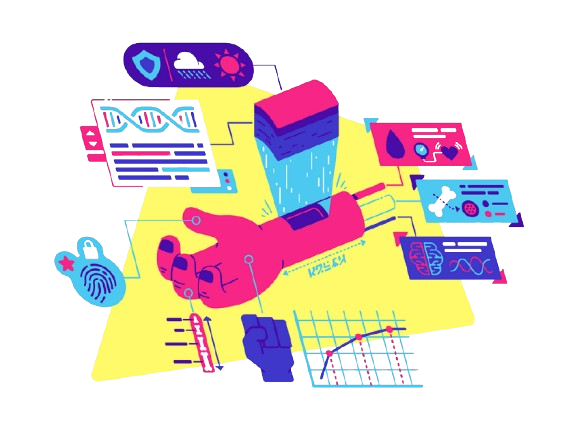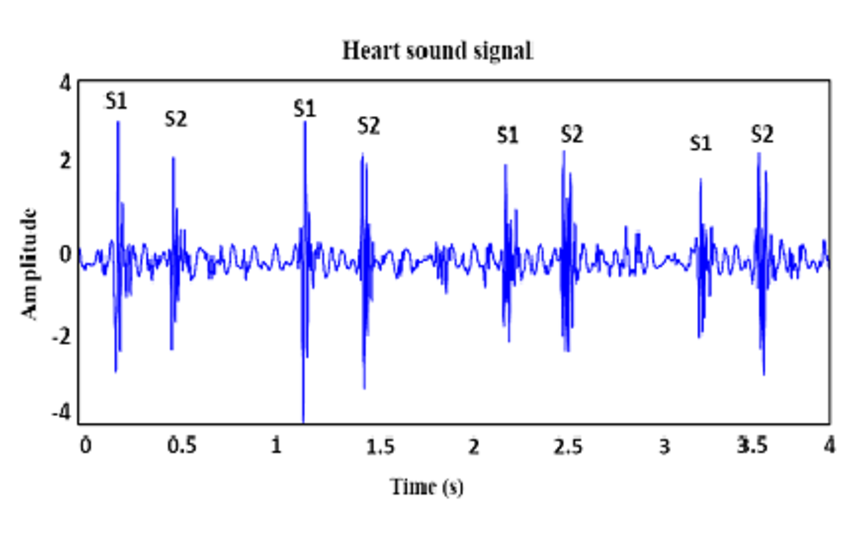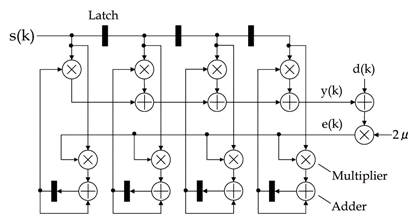About Our PCG Signal Analysis Project
Our Phonocardiogram (PCG) Signal Analysis Project explores new methods for processing heart sound recordings. We're working on applying adaptive filtering techniques to PCG signals, aiming to improve the clarity and interpretability of these recordings.
The project focuses on developing a multi-stage approach to analyze PCG signals. Our goal is to create tools that could potentially assist in cardiac health assessment, though we're still in the early stages of research and development. We hope our work might contribute to the broader field of cardiac signal processing.
View Project Details
Project Background
The Phonocardiogram (PCG) signal analysis project emerged from a critical need in cardiac health diagnostics. As cardiovascular diseases continue to be a leading cause of mortality worldwide, there's an increasing demand for more accurate, accessible, and non-invasive diagnostic tools. Our project aims to address this need by leveraging advanced signal processing techniques to analyze heart sounds captured through PCG.
PCG, a graphical representation of heart sounds, has been used in medical practice for decades. However, traditional methods of PCG analysis often fall short when it comes to detecting subtle abnormalities or when dealing with noisy environments. Our project seeks to overcome these limitations by employing cutting-edge adaptive filtering techniques and a novel multi-stage approach.


Detailed explanation of PCG signals
Phonocardiogram (PCG) signals are acoustic representations of heart sounds and murmurs. These signals are produced by the mechanical activity of the heart, including the opening and closing of heart valves, blood flow through the chambers, and potential abnormalities in cardiac structure or function.
A typical PCG signal consists of two main components:
- S1 (First Heart Sound): Occurs at the beginning of systole and is associated with the closure of the mitral and tricuspid valves.
- S2 (Second Heart Sound): Marks the end of systole and the beginning of diastole, caused by the closure of the aortic and pulmonary valves.
In addition to these primary components, PCG signals may also contain:
- S3 and S4 sounds: Less common, these can indicate various cardiac conditions.
- Murmurs: Abnormal sounds that can suggest valvular disorders or other cardiac abnormalities.

Challenges in PCG signal analysis
Analyzing PCG signals presents several significant challenges:
Noise Interference
PCG recordings are often contaminated by various types of noise, including ambient sounds, patient movement, and respiratory sounds. Distinguishing between actual heart sounds and these interfering noises is a major challenge.
Signal Variability
Heart sounds can vary significantly between individuals and even within the same individual under different conditions (e.g., rest vs. exercise). This variability makes it difficult to establish universal analysis parameters.
Low-Frequency Components
Many important features in PCG signals occur at low frequencies, which can be difficult to capture and analyze accurately.
Temporal Variations
The timing and duration of heart sounds can provide crucial diagnostic information, but accurately measuring these temporal aspects can be challenging, especially in the presence of noise or arrhythmias.
Feature Extraction
Identifying and extracting relevant features from PCG signals that can reliably indicate specific cardiac conditions is a complex task requiring advanced signal processing techniques.
Real-time Processing
For many applications, such as continuous monitoring, PCG analysis needs to be performed in real-time, adding computational constraints to the analysis process.
Our project aims to address these challenges through innovative signal processing techniques and machine learning algorithms.
Objectives
Our PCG signal analysis project has the potential to significantly impact cardiac health diagnostics in several ways as mentioned above.

Methodology
Our project employs advanced adaptive filtering techniques to process PCG signals. Adaptive filters are a class of digital filters that automatically adjust their parameters based on the input signal characteristics. This makes them particularly suitable for PCG signal analysis, where the signal properties can vary significantly between patients and recording conditions.
Key aspects of our adaptive filtering approach include:
Real-time Parameter Adjustment
The filter continuously updates its coefficients based on the incoming signal, allowing it to adapt to changing noise conditions or signal characteristics.
Multiple Filter Types
We utilize a combination of different adaptive filter types, including Least Mean Squares (LMS), Recursive Least Squares (RLS), and Kalman filters, each optimized for specific aspects of PCG signal processing.
Frequency-Selective Filtering
Our adaptive filters are designed to target specific frequency bands where heart sounds and murmurs typically occur, while attenuating noise in other frequency ranges.
Non-linear Filtering Elements
To handle the complex, non-linear nature of some PCG signal components, we incorporate non-linear elements into our adaptive filtering framework.

Explanation of the multi-stage approach
Our PCG signal analysis employs a multi-stage approach to comprehensively process and interpret the complex cardiac signals. This approach allows us to tackle different aspects of the signal analysis problem in a structured and efficient manner. The stages include:
Preprocessing
- Signal segmentation to isolate individual heartbeats
- Initial noise reduction using traditional digital filters
- Normalization to account for amplitude variations
Adaptive Filtering
- Application of our advanced adaptive filtering techniques to further reduce noise and enhance signal quality
- Separation of heart sounds from murmurs and other cardiac events
Feature Extraction
- Time-domain feature extraction (e.g., duration of heart sounds, timing intervals)
- Frequency-domain feature extraction using techniques like Short-Time Fourier Transform (STFT) and Wavelet Transform
- Non-linear feature extraction to capture complex signal dynamics
Post-processing and Interpretation
- Integration of classification results with other available patient data
- Generation of summary reports and visualizations for clinical interpretation
Each stage in this approach is designed to build upon the results of the previous stages, culminating in a comprehensive analysis of the PCG signal.
Expected Outcomes
Potential impacts on cardiac health diagnostics
Our PCG signal analysis project has the potential to significantly impact cardiac health diagnostics in several ways:
Improved Accuracy
By employing advanced signal processing and machine learning techniques, we aim to achieve higher accuracy in detecting and classifying cardiac abnormalities compared to traditional auscultation methods.
Earlier Detection
The enhanced sensitivity of our analysis may allow for the detection of subtle cardiac abnormalities at earlier stages, potentially leading to earlier interventions and improved patient outcomes.
Non-invasive Screening
Our technology could provide a powerful, non-invasive screening tool for cardiac health, potentially reducing the need for more invasive or expensive diagnostic procedures in some cases.
Accessibility
By developing a system that can work with relatively inexpensive PCG recording devices, we could make advanced cardiac diagnostics more accessible, particularly in resource-limited settings or for remote healthcare applications.
Continuous Monitoring
The real-time processing capabilities we're developing could enable continuous cardiac monitoring, providing a more comprehensive view of a patient's cardiac health over time.
Support for Healthcare Providers
Our system could serve as a valuable support tool for healthcare providers, offering a second opinion or highlighting potential issues that warrant further investigation.
Standardization
By providing objective analysis of heart sounds, our system could help standardize cardiac auscultation practices, potentially reducing variability in diagnoses between different healthcare providers.
Future applications of the technology
Looking ahead, our PCG signal analysis technology has potential applications that extend beyond its initial focus:
Wearable Health Monitoring
Integration with wearable devices could allow for continuous, non-intrusive cardiac monitoring in daily life, providing early warning of potential cardiac issues.
Telemedicine
The technology could be a valuable tool in telemedicine applications, allowing for remote cardiac assessments with a level of detail previously requiring in-person visits.
Personalized Medicine
By analyzing patterns in an individual's heart sounds over time, the technology could contribute to more personalized cardiac care and treatment plans.
Integration with Other Diagnostic Tools
Future developments could see our PCG analysis integrated with other diagnostic methods (e.g., ECG, echocardiography) for more comprehensive cardiac assessments.
Application to Other Biological Sounds
The signal processing techniques we're developing could potentially be adapted for analysis of other biological sounds, such as lung sounds or fetal heart sounds.
AI-assisted Medical Training
Our system could be used as a training tool for medical students and professionals, helping them learn to recognize and interpret various heart sounds and murmurs.
Research Tool
The detailed analysis provided by our system could serve as a valuable research tool, potentially uncovering new insights into cardiac function and disease progression.